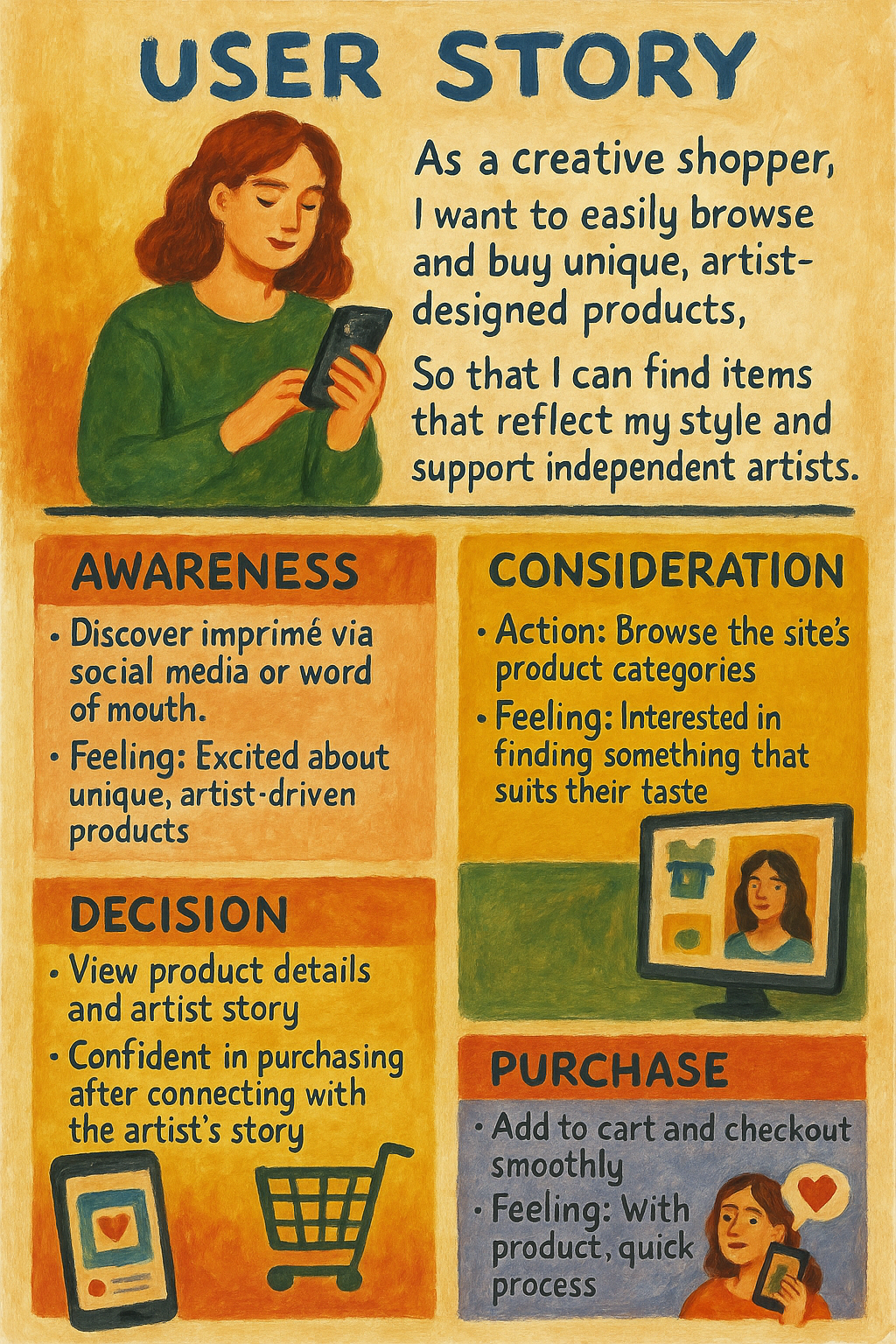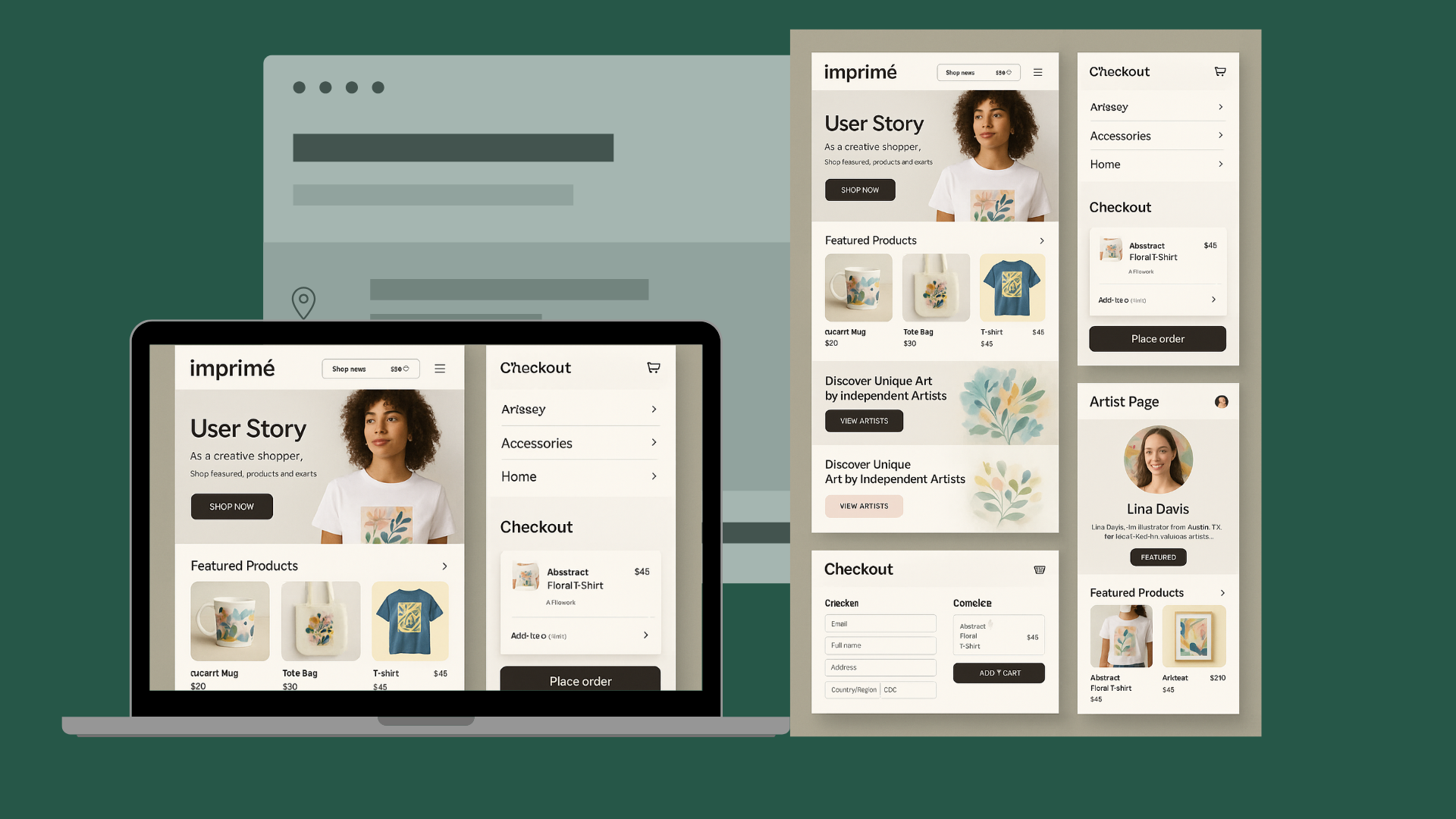imprimé
Overview:
imprimé is an e-commerce lifestyle brand that celebrates creativity by collaborating with emerging and established artists to transform their original artwork into wearable and functional art. From clothing and bags to mugs and home décor, imprimé makes unique, high-quality products that bring artistic expression into everyday life. Each collection is thoughtfully curated to showcase diverse artistic voices and support independent creatives, bridging the gap between art and audience through accessible, stylish merchandise.
Responsibilities:
Basic narrative analysis UX Research UI/UX Design
Aligning stakeholders on product goals
Competitors analysis
Empathy mapping
Information Architecture
User flows
Prototyping User testing following product strategy Etsy online store
Team & Timeframe:
The imprimé project is being developed by a dedicated team of four creatives, each bringing unique skills in design, marketing, e-commerce, and operations. Over the course of six months, the team has worked collaboratively to build the brand from the ground up—developing the concept, establishing artist partnerships, designing the product line, and launching the online store. With a shared passion for art and innovation, the team has combined strategic planning with creative execution to ensure a strong foundation for sustainable growth.
Objectives & Goals for Phase 1:
Objective:
To establish the foundation of the imprimé brand by building a strong visual identity, forming initial artist collaborations, and launching a fully functional e-commerce platform.
Goals for Phase 1:
Develop brand identity including logo, color palette, and brand voice
Collaborate with at least 5 artists to create the first product collection
Design and produce a range of printed products (e.g., clothing, bags, mugs)
Launch a user-friendly online store with integrated payment and shipping systems
Build an initial audience through social media, email marketing, and a soft launch campaign
Phase 2 – Growth & Marketing:
Focus on increasing brand awareness, expanding the artist network, and boosting sales through targeted marketing campaigns and influencer collaborations.
Phase 3 – Expansion & Diversification:
Introduce new product categories, explore retail or pop-up opportunities, and scale operations to reach a broader audience both locally and internationally.
Research & Analysis:
Extensive research and analysis played a key role in shaping the direction of imprimé. The team conducted market research to understand consumer trends, pricing strategies, and demand for artist-designed merchandise. Competitive analysis was carried out to identify gaps in the market and differentiate the brand from existing platforms. Surveys and interviews with artists and potential customers provided valuable insights into product preferences, design styles, and purchasing behaviors. This research informed decisions on product offerings, platform design, and marketing strategy, ensuring the brand is aligned with both creative and commercial goals.
Empathy & Personas:
Understanding our audience is at the heart of imprimé. We engaged with both artists and customers through interviews, social media polls, and user feedback to build empathy and identify their needs, values, and frustrations. This allowed us to craft tailored experiences and meaningful connections through our product offerings
Persona 1 – The Independent Artist
Name: Lina, 29
Occupation: Freelance Illustrator
Goals: Showcase her work beyond galleries, earn passive income
Frustrations: Limited platforms that respect artistic ownership and pay fairly
Needs: Exposure, collaboration opportunities, fair revenue sharing
Persona 2 – The Creative Shopper
Name: Alex, 34
Occupation: Graphic Designer
Goals: Find unique, meaningful items that reflect personal style
Frustrations: Mass-produced fashion, lack of connection to products
Needs: Access to artist-made products, ethical shopping, story-driven purchases
Site Architecture:
The site architecture of imprimé was designed to offer a smooth, engaging user experience that balances artistic storytelling with easy navigation. The homepage introduces the brand and showcases featured collections, while the “Shop” section allows users to browse by category (e.g., clothing, accessories, home décor) or by artist. A dedicated “Artists” page highlights collaborators and their stories, adding depth and transparency. The site also includes a blog for updates and interviews, a streamlined cart and checkout flow, and a responsive design optimized for both desktop and mobile users.
User Story & Journey:
As a creative shopper, the user discovers imprimé through social media or word of mouth and is excited to find unique, artist-designed products. They browse the website’s product categories and feel intrigued by the variety. After exploring product details and the artist’s story, the user feels confident in making a purchase, enjoying a smooth and simple checkout process.
Post-purchase, the user receives their order and is satisfied with the product. They share their experience on social media, feeling happy to support independent artists and engage with the brand. This journey reflects a seamless experience from discovery to purchase, leaving the user eager to return.
Wireframing:
Wireframing played a key role in shaping the structure and functionality of the imprimé website. It allowed us to visualize the layout, organize content hierarchy, and map out the user journey before diving into visual design. By creating low-fidelity and then mid-fidelity wireframes, we were able to test ideas quickly, gather feedback, and iterate efficiently. This step ensured clarity in navigation, alignment with user goals, and a strong foundation for the high-fidelity prototype that followed.
High Fidelity Prototype:
A High Fidelity Prototype for imprimé would be a polished, interactive version of the website, closely mirroring the final product with detailed visual design elements, including brand colors, typography, and images. It would feature fully designed pages such as the homepage, product pages with detailed descriptions, artist profiles, and an intuitive checkout flow. The prototype would include interactive elements like hover effects, dropdown menus, and a responsive design that adapts seamlessly across desktop, tablet, and mobile devices, providing a realistic user experience for testing and refinement.
Challenge & Conclusion:
One of the main challenges in developing imprimé was balancing artistic expression with a functional, user-friendly shopping experience. Ensuring that the platform honored the individuality of each artist while maintaining a cohesive brand identity required thoughtful design and constant user feedback. We also had to address technical constraints such as responsive design, smooth checkout flow, and artist collaboration tools within a limited 6-month timeframe.
In conclusion, imprimé successfully bridges the gap between creativity and commerce by offering a platform that supports independent artists and connects them with customers who value meaningful, story-driven products. Through a user-centered design approach, iterative development, and collaborative teamwork, we created a functional and emotionally resonant e-commerce experience








